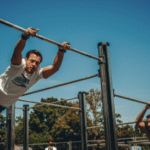Tailoring Private Calisthenics for Different Body Types
Developed by William Sheldon in the 1940s, somatotypes are broad classifications that describe general body composition and how individuals tend to gain or lose muscle and fat.
Ectomorph:
Characteristics: Naturally thin, lean build, long limbs, small joints, narrow shoulders and hips. They have a naturally fast metabolism, making it challenging to gain both fat and muscle mass (“hardgainers”). They typically have low body fat.
Calisthenics Relevance: May struggle initially with absolute strength for bodyweight movements due to minimal muscle mass. Their lighter frame can be advantageous for skills requiring high strength-to-weight ratio once strength is built, but building the prerequisite strength can be a slower process.
Mesomorph:
Characteristics: Naturally athletic, muscular build, medium bone structure, broad shoulders, narrow waist, and a balanced metabolism. They tend to gain muscle and lose fat relatively easily.
Calisthenics Relevance: Often excel in calisthenics due to natural strength and a favorable strength-to-weight ratio. They can pack on muscle easily, but may need to manage their bulk for very advanced bodyweight skills.
Endomorph:
Characteristics: Broader, rounder, or stockier build with a tendency to store fat more easily. They often have a slower metabolism, wider bones, and larger joints. While they may struggle to lose fat, they are often naturally very strong.
Calisthenics Relevance: May find initial bodyweight movements challenging due to a higher absolute body weight relative to their initial strength. Progressing to advanced skills that require lifting their entire body (e.g., pull-ups, handstands) might take more time due to the strength-to-weight ratio. However, once body fat is managed and foundational strength is built, they can become incredibly powerful in static holds.
—
Tailoring Private Calisthenics for Each Body Type in Houston
A private calisthenics coach in Houston will go beyond generic programs, making specific adaptations for each somatotype:
- For the Ectomorph (The “Hardgainer” for Muscle & Strength):
Primary Challenge: Building sufficient muscle mass and absolute strength for bodyweight movements.
Calisthenics Training Strategy:
Higher Volume for Hypertrophy: Focus on achieving adequate weekly sets and repetitions for muscle groups, often in the 8-15 rep range (or longer TUT for holds). This might involve higher frequency (e.g., training a muscle group 3 times a week).
Emphasis on Compound Movements: Prioritize fundamental calisthenics exercises that recruit multiple muscle groups (push-ups, pull-ups, squats, dips, rows) to maximize muscle fiber recruitment and anabolic response.
Controlled Tempo & Time Under Tension (TUT): Slow, controlled repetitions, especially during the eccentric (lowering) phase, to increase mechanical tension and metabolic stress, promoting muscle damage and growth.
Strategic Use of Regressions: While their light frame can be an advantage for skills later, initially, they may need more regressed variations (e.g., incline push-ups, assisted pull-ups, box squats) to build foundational strength without overtaxing their system.
Progressive Overload through Difficulty & Volume: Focus on gradually increasing the difficulty of exercises and total work done. Weighted calisthenics might be introduced sooner if bodyweight gains slow down, to provide additional overload.
Recovery Focus: Emphasize longer rest periods between sets (2-3 minutes) to allow for full recovery and maximum effort on subsequent sets, preventing excessive calorie burn.
Nutrition Guidance (Crucial):
A private coach will work closely on nutrition, often recommending a consistent calorie surplus with a high protein intake (e.g., 1.6-2.2g per kg of body weight) to support muscle growth. They might suggest frequent, nutrient-dense meals and healthy fats to increase caloric intake.
Coach’s Role: Manage expectations regarding muscle gain speed, prevent overtraining (as ectomorphs can push too hard without seeing results), and provide constant motivation.
- For the Mesomorph (The “Natural Athlete” for Strength & Muscle):
Primary Advantage: Natural propensity for building muscle and strength; good response to various stimuli.
Calisthenics Training Strategy:
Varied Volume & Intensity: Mesomorphs respond well to periodization that cycles through different phases (e.g., hypertrophy blocks, strength blocks, skill blocks). They can tolerate higher intensities and varied rep ranges.
Balance of Strength & Skill: The coach will balance foundational strength work with dedicated skill acquisition drills (e.g., handstands, levers, muscle-ups).
Progressive Overload Across All Variables: They can effectively manipulate exercise difficulty, volume, intensity, and density to continually challenge the body. Weighted calisthenics can be incorporated early for continued strength gains.
Focus on Refinement: As they progress quickly, the coach will emphasize refining technique and efficiency to prevent injury and unlock advanced skills.
Managing Strength-to-Weight Ratio: While they gain muscle easily, the coach might guide nutrition to maintain an optimal strength-to-weight ratio for advanced calisthenics skills.
Nutrition Guidance:
A balanced approach is often key, ensuring adequate protein for muscle maintenance/growth, and adjusting carb/fat intake based on current goals (e.g., slight deficit for leaning out for skills, maintenance for strength).
Coach’s Role: Keep training challenging and varied to prevent boredom, ensure comprehensive development, and continually push boundaries while managing recovery.
- For the Endomorph (The “Naturally Strong” Body with Higher Fat Storage):
Primary Challenge: Optimizing strength-to-weight ratio by reducing body fat while building foundational strength.
Calisthenics Training Strategy:
Initial Focus on Foundational Strength & Regressions: The coach will start with more regressed variations (e.g., incline push-ups at a higher angle, extensive band-assisted pull-ups, box squats) to build the absolute strength needed to lift their body weight.
Higher Frequency of Fundamentals: Training foundational movements more frequently (e.g., 3-4 times a week per muscle group, with moderate volume per session) can help build strength and improve consistency.
Emphasis on High-Density Training & Metabolic Conditioning: Incorporate circuits, super-sets, and shorter rest periods to increase calorie expenditure and promote fat loss, contributing to metabolic stress.
Progressive Overload through Decreased Assistance: Focus on gradually decreasing the assistance used in exercises (e.g., thinner resistance bands for pull-ups, lower incline for push-ups) to increase the body’s relative load.
Body Awareness and Core Strength: Emphasize core engagement and proper body alignment from the start to build a strong foundation for all movements.
Nutrition Guidance (Paramount):
Nutrition is arguably the most critical component. A private coach will work closely, potentially with an RDN in Houston, to establish a consistent calorie deficit with adequate protein intake (e.g., 1.6-2.2g per kg of target body weight) to promote fat loss while preserving muscle. Emphasis will be on whole, unprocessed foods.
Coach’s Role: Manage expectations, provide clear progression pathways for fat loss and strength gain, offer strong accountability, and celebrate small victories to maintain motivation, as progress might appear slower initially due to the dual goal of fat loss and strength building.
—
The Private Coach’s Role in Tailoring for All Body Types in Houston
Regardless of somatotype, a private calisthenics coach in Houston is essential for this level of tailoring:
Comprehensive Assessment: They go beyond visual assessment, utilizing movement screens, strength tests, and discussions about lifestyle and goals to truly understand the client’s unique physiology.
Personalized Programming: They custom-design every aspect of the program (exercise selection, progressions, regressions, volume, intensity, frequency, rest periods) to match the client’s specific body type and how it responds to training.
Dynamic Adaptation: Programs are not static. The coach constantly monitors progress, energy levels, and recovery, making real-time adjustments to ensure continuous, safe, and effective training.
Nutrition Integration: They provide general nutrition guidance or refer to specialized RDNs in Houston, ensuring the client’s diet supports their training goals specific to their body type.
Psychological Support: They manage expectations, build confidence, and provide tailored motivation strategies to help clients overcome challenges inherent to their body type.
In conclusion, private calisthenics training in Houston is remarkably adaptable and effective for all body types. A skilled coach understands the unique metabolic and structural characteristics of ectomorphs, mesomorphs, and endomorphs, and meticulously tailors the training and nutrition strategies to optimize muscle gain, strength acquisition, skill mastery, and body composition, leading to sustainable and impressive results for every individual.

Tailoring Private Calisthenics for Different Body Types
Route
Calisthenics Gym Houston Functional Bodyweight Training
Secondary phone: (346) 483-3195
Email: info@calisthenicsclubhouston.com
URL: https://calisthenicsclubhouston.com/
Monday 6:00 AM - 7:00 PM Tuesday 6:00 AM - 7:00 PM Wednesday 6:00 AM - 7:00 PM Thursday 6:00 AM - 7:00 PM Friday 12:00 PM - 6:30 PM Saturday 9:45 AM - 12:00 PM Sunday 3:00 PM - 5:00 PM





